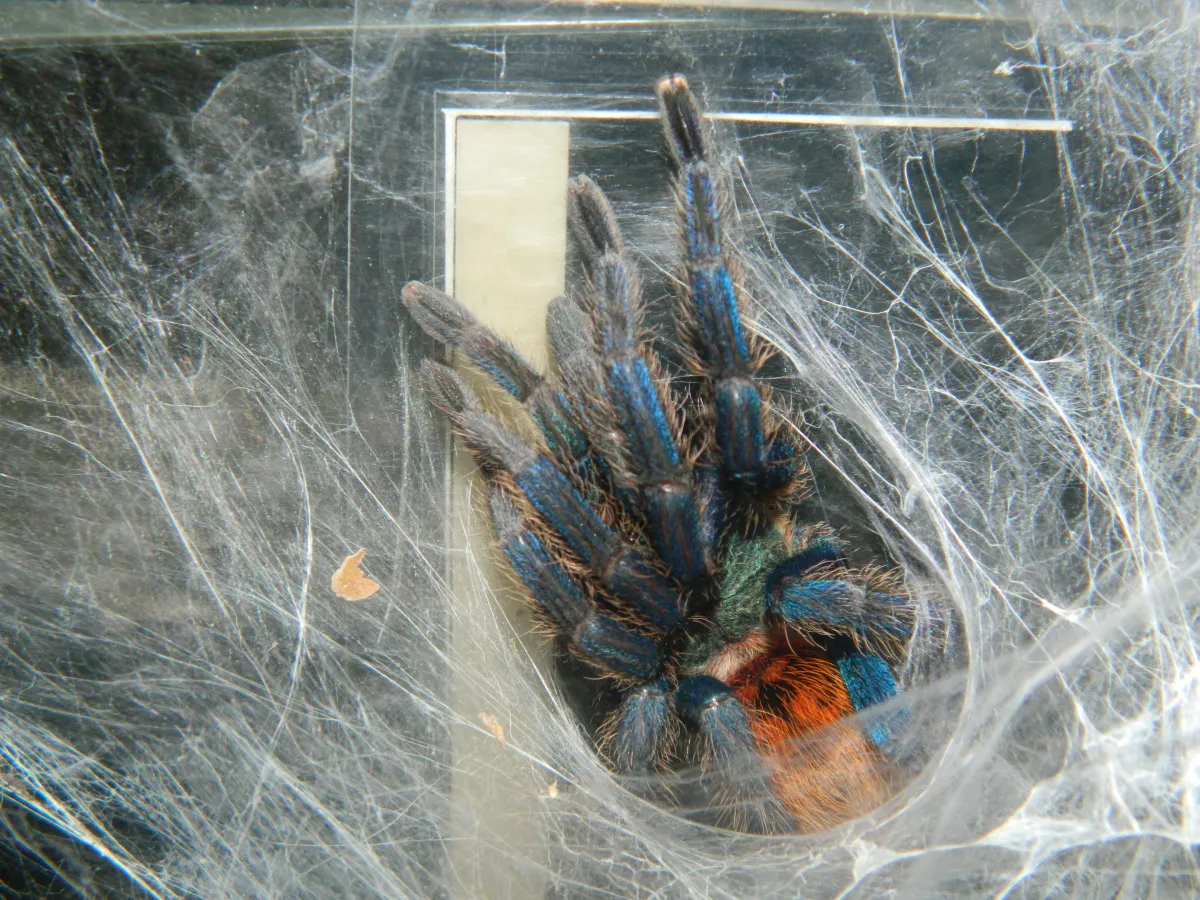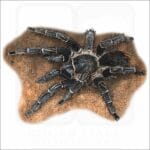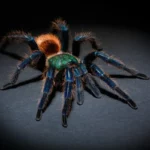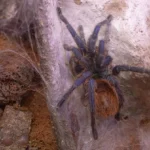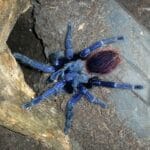Meet the Green Bottle Blue Tarantula, a vibrant and fascinating creature sure to catch your eye with its shimmering emerald green, electric blue, and neon orange colors. These curious arachnids can make great pets, but it’s important to understand their behavior and defense mechanisms. This comprehensive guide will delve into the Green Bottle Blue Tarantula’s temperament and defensive strategies, empowering you to appreciate and care for these amazing creatures with confidence.
Are Green Bottle Blue Tarantulas Aggressive?
Despite their striking appearance, Green Bottle Blue Tarantulas are not aggressive. They are generally docile and would prefer to retreat than attack. However, like any creature, they have their limits and will defend themselves if they feel threatened.
Their primary defense mechanism is their urticating hairs – barbed hairs on their abdomen that they can flick at perceived threats. Contact with these hairs causes irritation and itchiness and can be particularly troublesome if they get in your eyes.
While their venom is mild and not medically significant to humans, a bite can still be painful. Therefore, handling should be minimized and only done when absolutely necessary, such as during enclosure cleaning.
Debunking the Myth: Green Bottle Blue Tarantulas and Aggression
The Green Bottle Blue Tarantula’s striking appearance often leads to the misconception that they are aggressive. This is simply not true. These tarantulas are shy and prefer to avoid confrontation. Their first instinct is to retreat to safety rather than attack.
Their vivid blue-green coloration is not a sign of aggression, but rather an example of aposematism – a warning signal to predators that they are armed with irritating hairs and venom.
By understanding their behavior and respecting their boundaries, you can appreciate these creatures for the gentle giants they are.
If you are planning to keep green bottle blue tarantula as pets, you might want to read some information about this species to help you decide if this is a suitable species for you.
Green Bottle Blue Tarantulas: Defensive Behaviors and Handling Tips
Understanding a Green Bottle Blue Tarantula’s defense mechanisms and how to handle them properly is crucial for both your safety and the well-being of your eight-legged friend.
Defensive Behaviors:
- Urticating Hairs: As previously mentioned, they can flick barbed hairs from their abdomen, causing irritation and itching upon contact.
- Threat Posture: When threatened, they may raise their front legs and display their fangs in a defensive posture.
Handling Tips:
- Minimize Handling: Excessive handling is stressful for tarantulas. Only handle them when necessary, like rehousing.
- Slow Movements: Sudden movements can startle them. Approach and handle them slowly and calmly.
- Use Tools When Necessary: If you need to move them, use a soft paintbrush or a deli cup to gently guide them. Avoid touching them with bare hands whenever possible.
- Be Observant: Pay attention to their body language. If they seem agitated or defensive, give them space.
As a beginner, it is important to know what type of tarantula is best suited for your needs. Blue green bottle tarantula is a great choice for beginners as they are fairly docile and easy to care for.
Green Bottle Blue Tarantula Care Sheet: A Beginner-Friendly Guide
Green Bottle Blue Tarantulas can make fascinating and rewarding pets for both beginners and experienced keepers. Their relatively docile nature and straightforward care requirements make them a great option for those new to the world of tarantula keeping.
Housing:
- Enclosure: A 5-10 gallon tank is suitable for adults.
- Substrate: Use a moisture-retaining substrate like coco fiber to maintain humidity.
- Hide: Provide a hide for them to retreat to when they feel stressed or need privacy.
- Water Dish: Offer a shallow water dish to prevent drowning.
Environment:
- Temperature: Maintain a temperature between 72°F and 82°F.
- Humidity: Aim for a relative humidity of 60-70%. Mist the enclosure as needed to maintain moisture.
- Lighting: Ambient room lighting is sufficient. Avoid direct sunlight as it can overheat the enclosure.
Diet:
- Food: Feed a variety of live insects such as crickets, roaches, and mealworms.
- Feeding Frequency: Feed juveniles 2-3 times per week, and adults once a week.
- Remove Uneaten Food: Discard any uneaten prey items after 24 hours to prevent mold growth and potential harm to your tarantula.
However, if you decide to go with green bottle blue tarantula as your first pet, you should know that this type of tarantula is known to grow larger.
Key Points:
- Green Bottle Blue Tarantulas are generally non-aggressive and prefer to avoid conflict.
- They have urticating hairs that they can flick as a defense mechanism, causing irritation and itchiness.
- Excessive handling and sudden movements near their enclosure can stress them out.
- Bites are rare and unlikely unless they feel threatened, and their venom is mild for humans.
- Respecting their boundaries, handling them with care, and minimizing disturbances will help maintain a happy tarantula.
- They can make suitable pets, especially for beginners, due to their relatively calm nature.
Condensed & Organized Context:
Temperament and Handling:
- Not aggressive, but can act defensively
- Agile and difficult to handle
- Urticating hairs can cause pain and swelling
- Skittish and easily frightened
Physical Characteristics:
- Beautiful iridescent green cephalothorax
- Blue-green legs, hence the name
- Mildly venomous
Care and Habitat:
- Low humidity requirement
- Adapts to dry grasslands
- Easy to care for with a terrarium and insect diet
Unique Insights:
- Enrichment and Exercise: Providing climbing opportunities within their enclosure, such as cork bark or branches, can encourage natural behaviors and exercise.
- Behavioral Interactions: Green Bottle Blue Tarantulas are solitary animals and should not be housed together. In the wild, they typically only interact with each other for mating purposes.
- Lifespan and Reproductive Habits: Female Green Bottle Blue Tarantulas can live for 10-12 years, while males have a shorter lifespan of 3-5 years. Breeding these tarantulas can be challenging and requires experience and careful planning.
- Unlock Elemental 2 Secrets: Actionable Insights Now - April 2, 2025
- Lot’s Wife’s Name: Unveiling the Mystery of Sodom’s Fall - April 2, 2025
- Photocell Sensors: A Complete Guide for Selection and Implementation - April 2, 2025
